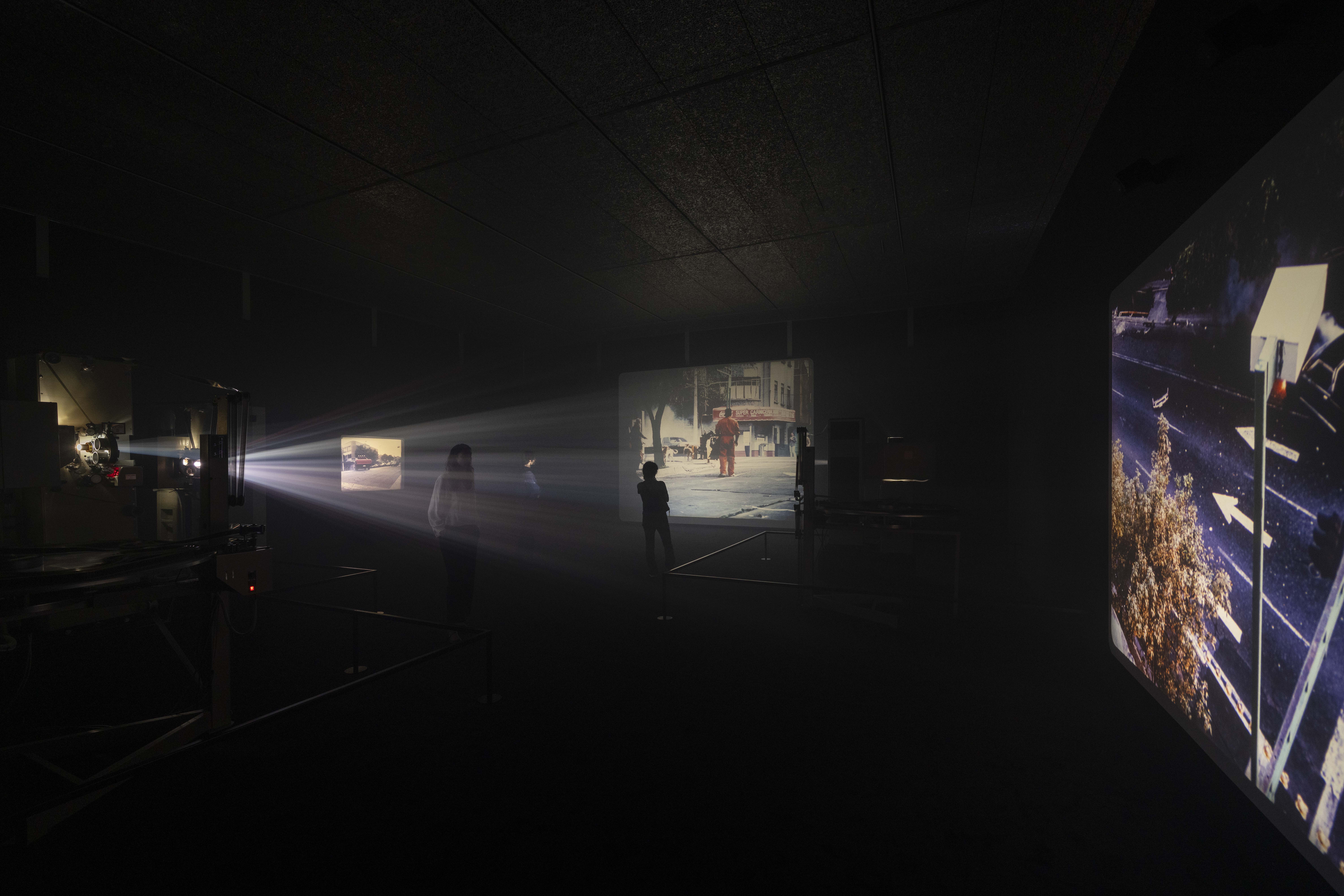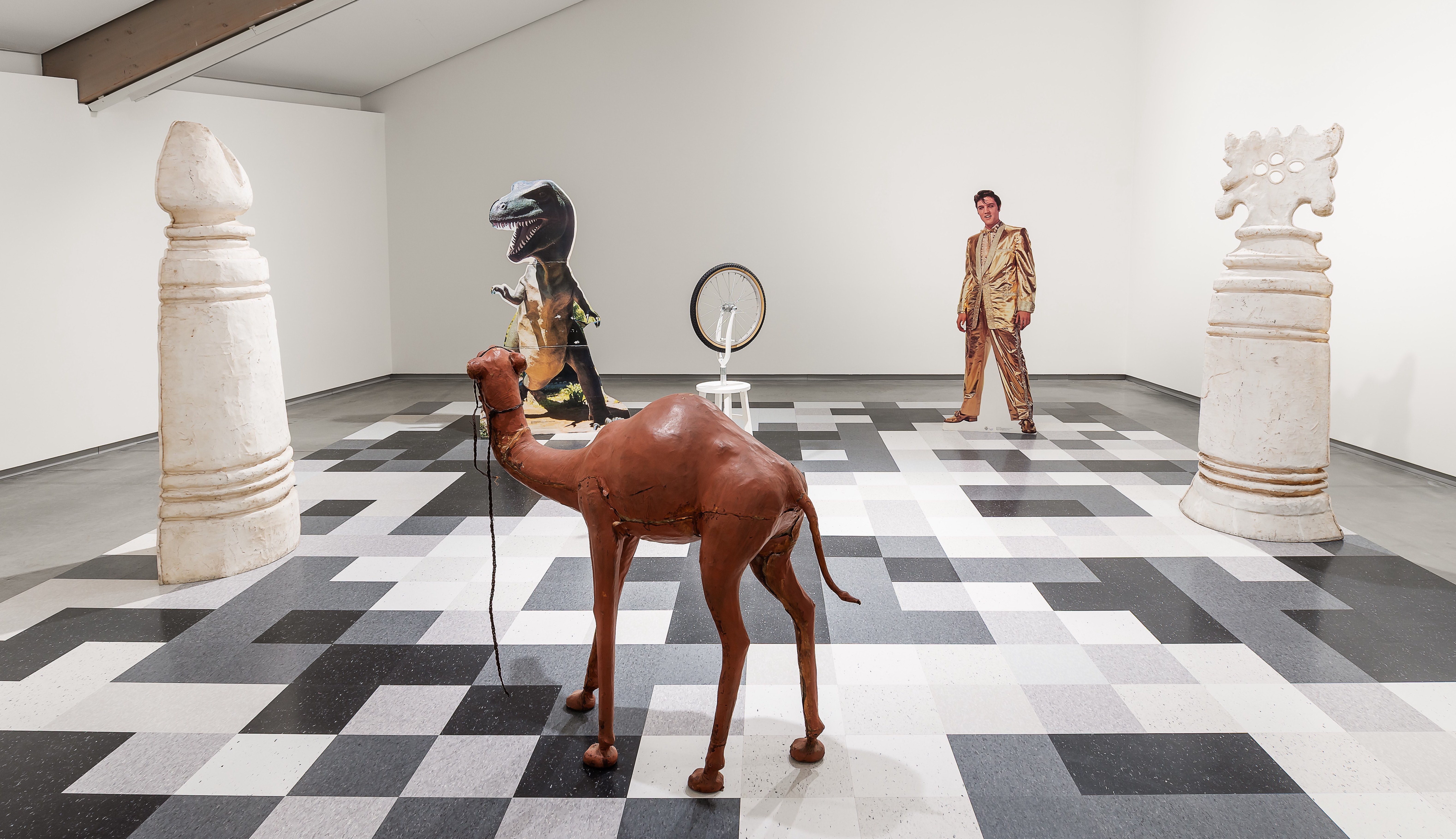First encounters: I, you, he, she, it, We, You, THEM 1
Weaving together personal histories while examining ideological and cultural knowledge, there is an inherent universality to Marina Xenofontos’ practice. Archival relics, discarded copies of the manufacturing production, or the exhaustive motion of a motor churning and spinning, the use of gestural narratives becomes a mode of being for the artist’s work and its afterlives.

Models, maquettes and mannequins usually appear in pre-production, as modes of thinking, realising, envisioning. In Xenofontos’ practice however, there is a central interest in depicting the narration of the material process, which itself holds all the personal references of the artist, while alluding to an open-ended, anti-hierarchal system of creating meaning. In failed cache, Xenofontos’ solo exhibition at Hot Wheels Athens in 2023, there was an evident reclaiming of pieces with a past life; pieces like Landing (2021), a cardboard maquette for the Ceiling Inferno 2 animation, covered with sulphur dust and Underpass (2010-2023), an MDF sculpture, its perspectival element pointing towards the 2010 engraving of a photograph she took of the underpass she walked through while going to school—a spot that was heavily charged with fear—were entering a new life through their being in the artist’s studio while taking their finalised material forms. Twice Upon a While (2020) is another example of this very refusal of any linear procedure; this time, between the analog and digital practices. Twice is a CNC carved mannequin, a figure suspended somewhere between its physical being and its reflected double, depicting a virtual quality deeply embedded in the mannequin’s history of coming to life. The figure tends toward a shaping or a human crafting that includes a temporal change. The figure’s agency is its historicity—it finds its dynamics in the inherent incompletion of history. Its original form was that 3 of a video game, the story of Twice, a girl that kept failing every task she was asked to complete.

With every failure the character glitched, disintegrating into mere pixels and then dissolving into the abyss of the screen. It’s like Twice was dissipating digitally only to reappear in her analog form, ready to be assembled again manually while offering a view into the relation between things and their sometimes invisible simulacra or ghosts. This supple transference embodied by a figure, which is also a simultaneity, gives occasion to the desire to interpret. 4

In a time where technological advances are happening more rapidly than ever, Xenofontos’ kinetic gestures reference the beginning. With a nod to the industrial revolution, the motors-turned- sculptural innuendos, are always working in clockwork motions. In Control Board #1 (2023) and Control Board #2 (2023), the copper cylinders that line Sculpture Centre’s walls in In Practice, frame the space with a subtle, ongoing kinetic energy. Wired to MDF control boards equipped with sound and motion sensors, the motor’s speeds accelerate or decelerate depending on the inputs received from their surroundings. Going beyond what is visible, these often hidden 5 operational mechanisms are brought on the surface, becoming the breathing lungs of the space, as they directly respond to the pace of the audience. This experiential association of the human, the machine, and their inevitable interaction at once discards and reinforces the idea of One and the Other. The human body has been compared, insofar as the source of movement is concerned, with a machine that functions by means of heat. We know that no machine ever creates energy. The most perfect motors can do no more than transform heat into movement writes Fernard Lagrange, however, Xenofontos’ proposed analogy is always in a recurring state of a masterful alliance.

By extending the notion of this very interaction in Evacuation Plan (2023), Xenofontos introduces another element, that of the artist’s self. Glimpses of herself as a teenager in photographic matter; close-ups of her ear, eye, mouth, tongue, belly or back, offer an intimate view of a fragmented self-portrait. Once in close range, the sound and motion sensors activate the blinking lights on the MDF boards, forming countless constellations. Part fiction, part autobiography, with every step, every sound, she wants to catch things looking back: seeing things, seeing themselves, being seen. At that, she is generating motion around an object, an idea. Fearlessly defying any notion of 7 hierarchical schemata, Xenofontos’ world is painted in familial gestures, each one waiting for the next to give way in a re-imagination of the symbolic, found somewhere between soft poetics and hard materiality.
1 Marina Xenofontos, I, you, he, she, it, We, You, Them, 2015, Stickers on stainless steel sheet, 50 x 50 cm, Karat Castle, Neoterismoi Toumazou, 2015
2 “Ceiling Inferno” album release, 2021, http://twiceuponawhile.com/ceiling-inferno
3 Lisa Robertson on Erich Auerbach’s Figura, Nilling, p. 11
4 Ibid.
5 Excerpt from Sculpture Centre’s PR: https://www.sculpture-center.org/exhibitions/13696/in-practice-marina- xenofontos
6 Fernand Lagrange, Physiologie des Exercises du Corps
7 File Note 148: Marina Xenofontos, Prisoner’s Cinema by Sabrina Tarasoff, https://camdenartcentre.org/file-notes/file- note-148-marina-xenofontos




